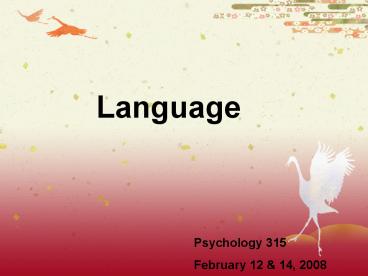Language - PowerPoint PPT Presentation
1 / 29
Title: Language
1
Language
Psychology 315 February 12 14, 2008
2
What is Language?
- Language is a code to translate thoughts into
output and input into thoughts - Communication with others
- Self-communication reflect, understand, explain
and make decisions
I would rather be at the beach than study but I
should..
Of course I will go to the library with you.
3
Overview of Components of Language
- Morphemes
- Lexicon
- Semantics
- Syntax
- Prosody
- Pragmatics
- Narrative
4
Language Development
- Discrimination of language components in infancy
- Production of first words
- Production of first sentences
- Increasing ability to use more sophisticated
forms of language (e.g. humour, sarcasm,
metaphors). - Continues to develop into adulthood
- Critical period for language acquisition
- Predicts language recovery after injury
- Myelination of language areas video
5
Language Lateralization
- The left hemisphere is dominant for language in
90 of right-handed individuals and 70 of
left-handed individuals (Knecht et al., 2000) - Left-handed individuals tend to recover language
functions faster after injury than right-handed
individuals as a result (Satz, 1979)
6
Neurophysiology of Auditory Language
- Primary Auditory Area (Heschls gyrus, Areas 41
and 42) - Perception of spoken language
- Wernickes Area (Area 22)
- Comprehension of spoken language
- Arcuate Fasiculus
- Association fiber bundle connecting Wernickes
and Brocas Areas - Brocas Area (Areas 44 and 45)
- Production of speech
- Initiation of speech via connections
- to supplementary motor area
Diagram Afifi, A. Bergman, R. (2005).
Functional Neuroanatomy Text and Atlas (2nd
Ed.). Toronto, ON McGraw-Hill.
7
Neurophysiology of Written Language
- Visual Cortex (Areas 17, 18, 19)
- Perception of words or images
- Angular Gyrus (Area 39)
- Comprehension of written language
- Auditory version of word is stimulated in
Wernickes Area by Angular Gyrus which then sends
info to Brocas Area.
8
Models of Reading and Spelling
- Dual-Route Theory (Coltheart, 1978)
- Lexical Route - Whole Word
- Non-Lexical Route - Phonetical
- Connectionist Theory (Seidenberg McClelland,
1989) - Single interconnected network of simple
processing units. - Whole word and phonological decoding are emergent
properties of system - Combined Theory (Bjaalid et al., 1997)
- Combines features of Dual-Route and Connectionist
Theory
9
Further Neurophysiology of Language
- Nonliteral Language
- Right hemisphere subcortical circuit
- Combination of hemispheres
- Prosody
- Right hemisphere regions analogous to left
hemisphere language regions. - Other cognitive contributors to language
- Attention
- Executive function
- Memory
- Processing Speed
10
Neurophysiology of Language
Diagram Demonet et al. (2005)
11
Syllabic/Logographic Languages
- Kana and Kanji system of Japanese
- Kanji - Japanese logographic writing system
- Kana - Japanese syllabic writing system
- Hiragana Katakana
- Writing Kana, activates the frontoparietal
cortical circuit in conjunction with the left
perisylvian area for spoken language whereas
writing Kanji, activates the frontoparietal
cortical circuit is used for motor execution in
conjunction with the left basal temporal area
(Nakamura Knouider, 2003). - Reading Kana activates the middle and inferior
occipital gyri and the deep perisylvian
temporoparietal area whereas reading Kanji,
activates the lateral fusiform gyrus (Sakurai et
al., 2000). - Can be a double dissociation after a brain injury
between kanji and kana
12
Illustration of three different orthographic
systems used in written Japanese. Patterson
Fushimi, 2006.
13
Sign Language
- Phonological language
- Left hemisphere dominance similar to that of
vocal language. - Aphasic syndromes
14
Disorders of Language
15
Aphasia
- A disturbance of language formation and
comprehension caused by localized brain
dysfunction - Most common causes are traumatic brain injury or
stroke. Others include tumors, degenerative
dementias, demyelinating disorders and
infections. - Testing Language Function
- Fluency
- Paraphasias
- Comprehension
- Repetition
- Naming
- Reading
- Writing
- Prosody
16
Brocas Aphasia
Broca's Aphasia Video
17
Wernickes Aphasia
Wernicke's Aphasia Video
18
A
B
Examples of dysgraphic writing from a patient
with Brocas Aphasia (a) and a patient with
Wernickes aphasia (b)(In response to a picture
stimuli). Brookshire (2003).
19
Conduction Aphasia
20
Global Aphasia
21
Transcortical Motor Aphasia
22
Transcortical Sensory Aphasia
23
Mixed Transcortical Aphasia
24
Other Aphasic Conditions
- Anomic Aphasia
- Subcortical Aphasia
- Primary Progressive Aphasia
25
Aphasia Decision Tree
Beeson, P. Rapcsak, S. (2006). The aphasias. In
P.J. Snyder, P.D. Nussbaum D.L Robins (Eds.).
Clinical Neuropsychology A Pocket Handbook for
Assessment (2nd Edition) (Chapter 18).
Washington, DC APA.
26
- Agraphia
- The loss or impairment of writing ability, caused
by acquired brain disease. - Broad classifications
- Aphasic agraphia accompanies aphasia
- Nonaphasic weakness and disorders of movement,
visusospatial function and conversion symptoms
27
- Gerstmanns syndrome
- 4 Primary Symptoms agraphia, acalculia
(acquired loss of math skills), finger agnosia
(inability to recognize, identify, differentiate,
name, select, indicate or orient the individual
fingers of own or others hands) and R-L
disorientation. - Associated with lesions of the left angular gyrus
28
Alexia
- Definition Acquired inability to read
- Type of sensory aphasia
- Also known as word blindness, text blindness,
visual aphasia
29
(No Transcript)































